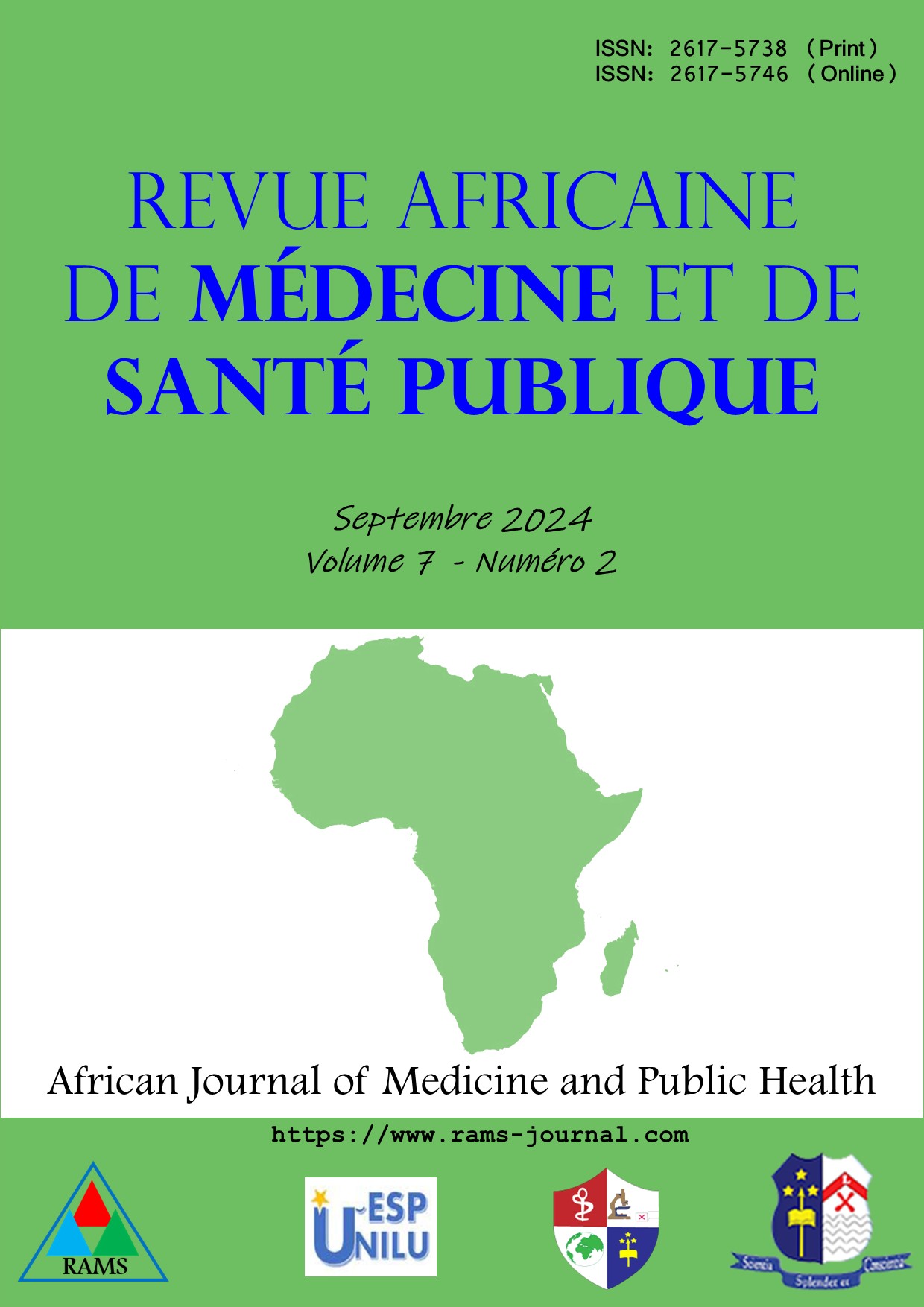Acute malnutrition in rural twins before their second birthday: insights from a cohort study in Burkina Faso.
Mots-clés :
Acute malnutrition, Rural, Twins, Second birthday, Burkina FasoRésumé
Background: Twins constitute a vulnerable subpopulation among children under 5 years of age. In sub-Saharan Africa, it has been found that multiple births tend to be undernourished and the risks of acute malnutrition and stunting are high.
Objective: Examining the relationship between acute malnutrition and twins in rural areas
Methods: This is a cohort study. 199 villages in the province of Sanmentenga, Burkina Faso. Multiple logistic regression was used to examine the relationship between acute malnutrition and twin status at birth after adjusting for wealth index, presence of latrines, main water source, fever, and presence of diarrhoea. The statistical threshold for significance was P < 0.05 and all analysis were performed using STATA version 14.0.
Results: A total of 708 children were included in the study, including 236 children born twins and 472 children born twins.non-twins. Children born to mothers younger than 18 years were more common among non-twins than among twins (5.6% vs. 1.0%, p = 0.001). Acute malnutrition was more common among twins than non-twins (42.1% versus 28.0%, p<0.001). Children with fever were more common among non-twins than among twins (10.2% versus 5.5%, p=0.04).After adjusting for the wealth index, the presence of latrines, the main source of water, the presence of fever and the presence of diarrhea, twins were 1.46 times more malnourished than single children (RR = 1.46 , 95% CI [1.17-1.81], p =0.001).
Conclusion: Children receiving rural health and nutrition education, twins were likely to be malnourished before their second birthday compared to non-twins.’ Particular attention should be paid to twins to reduce the risk of acute malnutrition before their second birthday.
Téléchargements
Références
Magadi MA. Cross-national analysis of the risk factors of child malnutrition among children made vulnerable by HIV/AIDS in sub-Saharan Africa: evidence from the DHS. Tropical Medicine & International Health [Internet]. [cité 28 juin 2018];16(5):570‑8. Disponible sur: https://onlinelibrary.wiley.com/doi/abs/10.1111/j.1365-3156.2011.02733.x
Reinbott A, Jordan I. Determinants of Child Malnutrition and Infant and Young Child Feeding Approaches in Cambodia. World Rev Nutr Diet. 2016;115:61‑7.
Sié A, Tapsoba C, Dah C, Ouermi L, Zabre P, Bärnighausen T, et al. Dietary diversity and nutritional status among children in rural Burkina Faso. Int Health. 1 mai 2018;10(3):157‑62.
Holditch-Davis D, Roberts D, Sandelowski M. Early parental interactions with and perceptions of multiple birth infants. J Adv Nurs. juill 1999;30(1):200‑10.
Poda GG, Hsu CY, Chao JCJ. Factors associated with malnutrition among children <5 years old in Burkina Faso: evidence from the Demographic and Health Surveys IV 2010. Int J Qual Health Care. 1 nov 2017;29(7):901‑8.
Cheah WL, Wan Muda WAM, Mohd Hussin ZA, Thon CC. Factors associated with undernutrition among children in a rural district of Kelantan, Malaysia. Asia Pac J Public Health. mars 2012;24(2):330‑42.
Development Initiatives. Rapport sur la nutrition mondiale 2017 : La nutrition au service des ODD. [Internet]. Bristol, Royaume-Uni; 2017 p. 115. Disponible sur: http://globalnutritionreport.org/wp-content/uploads/2017/11/Report_2017_French-1.pdf
Collins J. Global epidemiology of multiple birth. Reprod Biomed Online. 2007;15 Suppl 3:45‑52.
Pison G, D’Addato AV. Frequency of Twin Births in Developed Countries. Twin Research and Human Genetics [Internet]. avr 2006 [cité 28 juin 2018];9(2):250‑9. Disponible sur: https://www.cambridge.org/core/journals/twin-research-and-human-genetics/article/frequency-of-twin-births-in-developed-countries/26A0B60A621D3BE5B7AEB664010D822E
Gebremedhin S. Multiple births in sub-saharan Africa: epidemiology, postnatal survival, and growth pattern. Twin Res Hum Genet. févr 2015;18(1):100‑7.
Chang C. Raising twin babies and problems in the family. Acta Genet Med Gemellol (Roma). 1990;39(4):501‑5.
Langlois BK, Cliffer IR, Nikiema L, Suri DJ, Garanet F, Shen Y, et al. Factors that may influence effectiveness of four specialized nutritious foods in the prevention of stunting and wasting in children 6–23 months in Burkina Faso 1–4. Curr Dev Nutr [Internet]. [cité 15 janv 2020]; Disponible sur: https://academic.oup.com/cdn/advance-article/doi/10.1093/cdn/nzaa002/5697195
Cliffer IR, Perumal N, Masters WA, Naumova EN, Ouedraogo LN, Garanet F, et al. Linear Growth Spurts are Preceded by Higher Weight Gain Velocity and Followed by Weight Slowdowns Among Rural Children in Burkina Faso: A Longitudinal Study. J Nutr. 24 mars 2022;nxac071.
Cliffer IR, Masters WA, Perumal N, Naumova EN, Zeba AN, Garanet F, et al. Monthly measurement of child lengths between 6 and 27 months of age in Burkina Faso reveals both chronic and episodic growth faltering. The American Journal of Clinical Nutrition [Internet]. 12 oct 2021 [cité 13 oct 2021];(nqab309). Disponible sur: https://doi.org/10.1093/ajcn/nqab309
Cliffer IR, Naumova EN, Masters WA, Perumal N, Garanet F, Rogers BL. Peak timing of slowest growth velocity among young children coincides with highest ambient temperatures in Burkina Faso: a longitudinal study. The American Journal of Clinical Nutrition [Internet]. déc 2023 [cité 17 janv 2024];S0002916523661684. Disponible sur: https://linkinghub.elsevier.com/retrieve/pii/S0002916523661684
WHO child growth standards: length/height-for-age, weight-for-age, weight-for-length, weight-for-height and body mass index-for-age: methods and development [Internet]. [cité 6 juin 2023]. Disponible sur: https://www.who.int/publications-detail-redirect/924154693X
Vyas S, Kumaranayake L. Constructing socio-economic status indices: how to use principal components analysis. Health Policy Plan. nov 2006;21(6):459‑68.
Barros AJD, Hirakata VN. Alternatives for logistic regression in cross-sectional studies: an empirical comparison of models that directly estimate the prevalence ratio. BMC Med Res Methodol. 20 oct 2003;3:21.
Deddens JA, Petersen MR. Approaches for estimating prevalence ratios. Occup Environ Med. juill 2008;65(7):481, 501‑6.
StataCorp. 2015. Stata. Release 14. Statistical Software. College Station, TX [Internet]. Disponible sur: http://www.stata-journal.com/software/
Cuschieri S. The STROBE guidelines. Saudi J Anaesth. avr 2019;13(Suppl 1):S31‑4.






